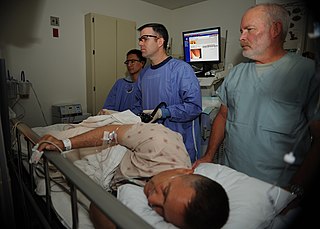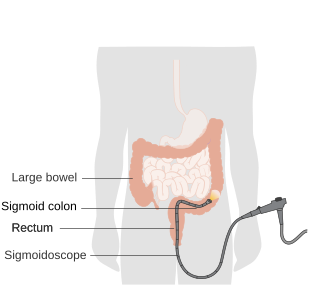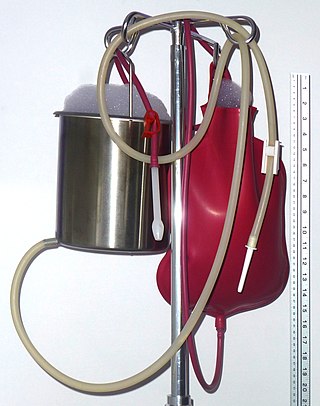
A carcinogen is any substance, radionuclide, or radiation that promotes carcinogenesis. This may be due to the ability to damage the genome or to the disruption of cellular metabolic processes. Several radioactive substances are considered carcinogens, but their carcinogenic activity is attributed to the radiation, for example gamma rays and alpha particles, which they emit. Common examples of non-radioactive carcinogens are inhaled asbestos, certain dioxins, and tobacco smoke. Although the public generally associates carcinogenicity with synthetic chemicals, it is equally likely to arise from both natural and synthetic substances. Carcinogens are not necessarily immediately toxic; thus, their effect can be insidious.

The large intestine, also known as the large bowel, is the last part of the gastrointestinal tract and of the digestive system in tetrapods. Water is absorbed here and the remaining waste material is stored in the rectum as feces before being removed by defecation. The colon is the longest portion of the large intestine, and the terms are often used interchangeably but most sources define the large intestine as the combination of the cecum, colon, rectum, and anal canal. Some other sources exclude the anal canal.

Colorectal cancer (CRC), also known as bowel cancer, colon cancer, or rectal cancer, is the development of cancer from the colon or rectum. Signs and symptoms may include blood in the stool, a change in bowel movements, weight loss, and fatigue. Most colorectal cancers are due to old age and lifestyle factors, with only a small number of cases due to underlying genetic disorders. Risk factors include diet, obesity, smoking, and lack of physical activity. Dietary factors that increase the risk include red meat, processed meat, and alcohol. Another risk factor is inflammatory bowel disease, which includes Crohn's disease and ulcerative colitis. Some of the inherited genetic disorders that can cause colorectal cancer include familial adenomatous polyposis and hereditary non-polyposis colon cancer; however, these represent less than 5% of cases. It typically starts as a benign tumor, often in the form of a polyp, which over time becomes cancerous.

Colonoscopy or coloscopy is a medical procedure involving the endoscopic examination of the large bowel (colon) and the distal portion of the small bowel. This examination is performed using either a CCD camera or a fiber optic camera, which is mounted on a flexible tube and passed through the anus.

Sigmoidoscopy is the minimally invasive medical examination of the large intestine from the rectum through to the nearest part of the colon, the sigmoid colon. There are two types of sigmoidoscopy: flexible sigmoidoscopy, which uses a flexible endoscope, and rigid sigmoidoscopy, which uses a rigid device. Flexible sigmoidoscopy is generally the preferred procedure. A sigmoidoscopy is similar to, but not the same as, a colonoscopy. A sigmoidoscopy only examines up to the sigmoid, the most distal part of the colon, while colonoscopy examines the whole large bowel.

In anatomy, a polyp is an abnormal growth of tissue projecting from a mucous membrane. If it is attached to the surface by a narrow elongated stalk, it is said to be pedunculated; if it is attached without a stalk, it is said to be sessile. Polyps are commonly found in the colon, stomach, nose, ear, sinus(es), urinary bladder, and uterus. They may also occur elsewhere in the body where there are mucous membranes, including the cervix, vocal folds, and small intestine. Some polyps are tumors (neoplasms) and others are non-neoplastic, for example hyperplastic or dysplastic, which are benign. The neoplastic ones are usually benign, although some can be pre-malignant, or concurrent with a malignancy.

The mesentery is an organ that attaches the intestines to the posterior abdominal wall and is formed by the double fold of peritoneum. It helps in storing fat and allowing blood vessels, lymphatics, and nerves to supply the intestines, among other functions.

Gardner's syndrome is a subtype of familial adenomatous polyposis (FAP). Gardner syndrome is an autosomal dominant form of polyposis characterized by the presence of multiple polyps in the colon together with tumors outside the colon. The extracolonic tumors may include osteomas of the skull, thyroid cancer, epidermoid cysts, fibromas, as well as the occurrence of desmoid tumors in approximately 15% of affected individuals.

A neoplasm is a type of abnormal and excessive growth of tissue. The process that occurs to form or produce a neoplasm is called neoplasia. The growth of a neoplasm is uncoordinated with that of the normal surrounding tissue, and persists in growing abnormally, even if the original trigger is removed. This abnormal growth usually forms a mass, which may be called a tumour or tumor.

Virtual colonoscopy is the use of CT scanning or magnetic resonance imaging (MRI) to produce two- and three-dimensional images of the colon, from the lowest part, the rectum, to the lower end of the small intestine, and to display the images on an electronic display device. The procedure is used to screen for colon cancer and polyps, and may detect diverticulosis. A virtual colonoscopy can provide 3D reconstructed endoluminal views of the bowel. VC provides a secondary benefit of revealing diseases or abnormalities outside the colon.

A furanolactone is a heterocyclic chemical compound that contains both lactone and furan rings in its chemical structure.
Edrecolomab is a mouse-derived monoclonal antibody targeting the cell-surface glycoprotein EpCAM (17-1A), which is expressed on epithelial tissues and on various carcinomas.

α-Eleostearic acid or (9Z,11E,13E)-octadeca-9,11,13-trienoic acid, is an organic compound, a conjugated fatty acid and one of the isomers of octadecatrienoic acid. It is often called simply eleostearic acid although there is also a β-eleostearic acid. Its high degree of unsaturation gives tung oil its properties as a drying oil.

Sodium-coupled monocarboxylate transporter 1 (i.e., SMCT1) and sodium-coupled monocarboxylate transporter 2 (i.e., SMCT2) are plasma membrane transport proteins in the solute carrier family. They transport sodium cations in association with the anionic forms (see conjugated base) of certain short-chain fatty acids (i.e., SC-FAs) through the plasma membrane from the outside to the inside of cells. For example, propionic acid (i.e., CH
3CH
2CO
2H) in its anionic "propionate" form (i.e., CH
3CH
2CO−
2) along with sodium cations (i.e., Na+) are co-transported from the extracellular fluid into a SMCT1-epxressing cell's cytoplasm. Monocarboxylate transporters (MCTs) are also transport proteins in the solute carrier family. They co-transport the anionic forms of various compounds into cells in association with proton cations (i.e. H+). Four of the 14 MCTs, i.e. SLC16A1 (i.e., MCT1), SLC16A7 (i.e., MCT22), SLC16A8 (i.e., MCT3), and SLC16A3 (i.e., MCT4), transport some of the same SC-FAs anions that the SMCTs transport into cells. SC-FAs do diffuse into cells independently of transport proteins but at the levels normally occurring in tissues far greater amounts of the SC-FAs are brought into cells that express a SC-FA transporter.
Mouse models of colorectal cancer and intestinal cancer are experimental systems in which mice are genetically manipulated, fed a modified diet, or challenged with chemicals to develop malignancies in the gastrointestinal tract. These models enable researchers to study the onset, progression of the disease, and understand in depth the molecular events that contribute to the development and spread of colorectal cancer. They also provide a valuable biological system, to simulate human physiological conditions, suitable for testing therapeutics.
A coffee enema is the injection of coffee into the rectum and colon via the anus, i.e., as an enema. There is no scientific evidence to support any positive health claim for this practice, and medical authorities advise that the procedure may be dangerous.

Colon cleansing, also known as colon therapy, or colon hydrotherapy, or a colonic, or colonic irrigation encompasses a number of alternative medical therapies claimed to remove unspecified toxins from the colon and intestinal tract by removing supposed accumulations of feces. Colon cleansing in this context should not be confused with an enema which introduces fluid into the colon, often under mainstream medical supervision, for a limited number of purposes including severe constipation and medical imaging.

Danielle Michelle "Diem" Brown[3] was an American television personality, philanthropist, and entertainment reporter. She was best known as a recurring cast member on the MTV reality television series The Challenge. She also founded MedGift, a web-based advocacy service that provides a gift registry for patients and support pages to both people experiencing illnesses and their caregivers. Before her family settled in the United States, Diem and family moved frequently due to her father’s Army postings. Diem spent a significant amount of her pre-high school childhood in Baumholder, Germany. She attended high school in Roswell, Georgia and obtained her bachelor's degree in communications from Florida State University. She was a member of Delta Gamma sorority.
National Colon Cancer Awareness Month is an annual celebration observed in the United States during the month of March, to increase awareness of colorectal cancer. In the United States it is organized by the Colorectal Cancer Alliance, Fight Colorectal Cancer, the Colon Cancer Coalition, and numerous other organizations and survivor networks.
hPG80 refers to the extracellular and oncogenic version of progastrin. This name first appeared in a scientific publication in January 2020. Until that date, scientific publications only mention 'progastrin', without necessarily explicitly specifying whether it is intracellular or extracellular in the tumor pathological setting.
















